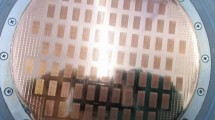Abstract
The chip-on-glass bonding process is one of the most effective packaging methods that can satisfy the need for thin, large, low-cost and light display panels in the liquid crystal display (LCD) industry. This process uses an anisotropic conductive film (ACF) as the adhesion layer between the driver chip and the LCD panel and is based on thermocompressing bonding. Thus, the proper temperature conditions, such as temperature level and even distribution over the film, can play the vital role in the improvement of bonding performance, quality, and reliability. A finite element analysis model for predicting temperature distributions in all the components of the process equipment as well as the driver chip, the LCD panel and the ACF is presented. The accuracy of the developed model is verified by comparing the simulated temperature distribution with the actual one. Consequently, the model is used in determining the tooltip dimension to introduce proper temperature distribution to the driver chip and the film.
Similar content being viewed by others
References
G. P. Crawford (Ed.), Flexible Flat Panel Display Technology, John Wiley & Sons Ltd., West Sussex, UK (2005).
S. Jang, M. Yuh, D. Lee, S. Jeong and H. Jeong, Chemical mechanical planarization of advanced package substrate by controlling selectivity of copper to polymer, Journal of Mechanical Science and Technology, 32 (2018) 3843–3848.
I. Watanabe, T. Fujinawa, M. Arifuku, M. Fujii and G. Yasushi, Recent advances of interconnection technologies using anisotropic conductive films in flat panel display applications, 9th International Symposium on Advanced Packaging Materials: Processes, Properties and interfaces, Atlanta, Georgia, USA (2004) 11–16.
C.-Y. Ni, K.-S. Yoon, H.-J. Ahn and C.-I. Chen, Recipe optimization and design software development of tape carrier package (TCP) inner lead bonding (ILB), IEEE Transactions on Electronics Packaging Manufacturing, 28 (2005) 150–157.
L. L. Mercado, J. White, V. Sarihan and T.-Y. Lee, Failure mechanism study of anisotropic conductive film (ACF) packages, IEEE Transactions on Components and Packaging Technologies, 26 (2003) 509–516.
G. Ni et al., Automatic optical inspection of bump offsets in flex-on-glass bonding using differential interference contrast imaging, International Journal of Precision Engineering and Manufacturing, 21 (2020) 1–11.
M. J. Yim and K. W. Paik, Recent advances on anisotropic conductive adhesives (ACAs) for flat panel displays and semiconductor packaging applications, International Journal of Adhesion and Adhesives, 26 (2006) 304–313.
J. Souk, S. Morozumi, F.-C. Luo and I. Bita, Flat Panel Display Manufacturing, John Wiley & Sons Ltd. (2018).
M. Uddin, M. Alam, Y. Chan and H. Chan, Adhesion strength and contact resistance of flip chip on flex packages—effect of curing degree of anisotropic conductive film, Microelectronics Reliability, 44 (2004) 505–514.
Y. H. Jeong, S.-W. Jung, S. Jin, K.-S. Kim and W.-S. Yun, Optimization and reliability evaluation of COG bonding process, Journal of Mechanical Science and Technology, 30 (2016) 1305–1313.
H. Gao, W. Zhang, Z. Zhang, L. Gao and G. Chen, Study on fatigue life and electrical property of COG assembly under thermal-electric-mechanical coupled loads, Microelectronics Reliability, 56 (2016) 148–154.
H. Gao, Y. Wang, B. Song and W. Zhang, Resistance analysis and fatigue life of COG assemblies under thermal cycle aging, IEEE Transactions on Device and Materials Reliability, 17 (2017) 463–471.
S. W. Jung, W. S. Yun, S. Jin, B. S. Kim and Y. H. Jeong, Flexure mechanism-based parallelism measurements for chip-on-glass bonding, Smart Materials and Structures, 20 (2011) 085008.
M. H. Hong, S.-C. Kim and Y.-H. Kim, Ultra-fine pitch chip-on-glass (COG) bonding with metal bumps having insulating layer in the side walls using anisotropic conductive film (ACF), Current Applied Physics, 12 (2012) 612–615.
W. K. Roots, Fundamentals of Temperature Control, Academic Press, New York, USA (2014).
Acknowledgments
This work was supported by the National Research Foundation of Korea (NRF) grant funded by the Korea government (MSIT) (No. NRF-2018R1A2B2009540).
Author information
Authors and Affiliations
Corresponding author
Additional information
Recommended by Editor Hyung Wook Park
Won-Soo Yun is a Professor of the Department of Mechanical Engineering, Korea Polytechnic University, Siheung, Korea. He received his Ph.D. in Mechanical Engineering from POSTECH. His research interests include 3D bio-printing and tissue engineering.
Seung Won Jung is a Deputy General Manager of Inspection System Vision Department, KohYoung Technology, INC. Gyeonggi, Korea. He received his M.S. degree in Mechanical Engineering from Korea Polytechnic University. His research interests include vision system and software and hardware development.
Songwan Jin is a Professor of the Department of Mechanical Engineering, Korea Polytechnic University, Siheung, Korea. He received his Ph.D. in Mechanical and Aerospace Engineering from Seoul National University. His research interests include 3D bioprinting and microfluidics.
Young Hun Jeong is an Associate Professor of the School of Mechanical Engineering, Kyungpook National University, Daegu, Korea. He received his Ph.D. in Mechanical Engineering from POSTECH. His research interests include nano/micro manufacturing and biomaterials.
Rights and permissions
About this article
Cite this article
Yun, WS., Jung, S.W., Jin, S. et al. Analysis of temperature distribution in the chip-on-glass bonding process. J Mech Sci Technol 34, 3041–3047 (2020). https://doi.org/10.1007/s12206-020-0635-0
Received:
Revised:
Accepted:
Published:
Issue Date:
DOI: https://doi.org/10.1007/s12206-020-0635-0




